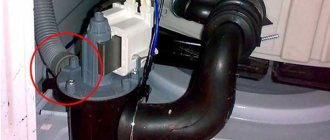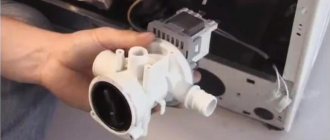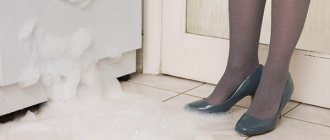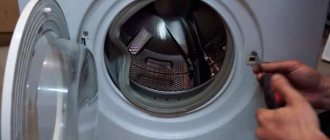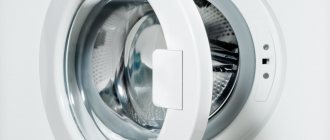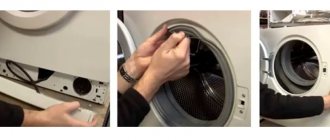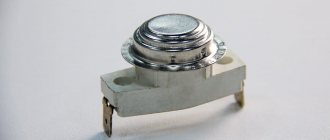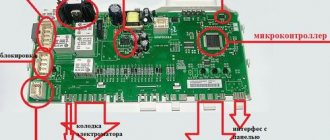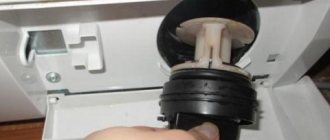Preparatory actions
Before you start working, you need to:
- Study the structure and manufacturing features of the door.
- Familiarize yourself with the basic techniques that specialists use when performing repairs.
- Prepare tools to do the job.
- Purchase the necessary auxiliary materials and original spare parts.
- If necessary, prepare equipment for making elements yourself.
Washing machine hatch door design
After determining the algorithm of actions, you should decide what and how you will have to do in order for the washing machine door to start functioning again.
Problems with the handle
Repairing a washing machine handle is sometimes necessary for the same reasons as replacing hinges. In order to change it, we remove and disassemble the door, as in the article on replacing hinges.
Most often, the handle lever that moves the mount to the machine body is damaged. To disconnect the handle, you need to press this hook while holding it on the front side of the hatch. The handle will come out of the groove, and you need to push it all the way up. After this, the handle can be easily removed. Reinstall the new part in reverse order and reassemble the door in reverse order. Be sure to carry out diagnostics in the rinsing mode.
The blocker is broken
If the lock is broken, it is impossible to turn on the washing machine, as this is contrary to safety regulations. The door may not close completely, causing water leakage and flooding. According to a well-known law, the hatch lock device fails when the door is closed. In this case, you need to remove the top cover. We find the lock latch with our hand between the body and the drum and open the hatch. In essence, replacing a blocker comes down to replacing the entire lock.
Using a screwdriver, release the rubber seal from the clamp and remove the gasket. Then unscrew the two bolts and remove the lock. We remove the connector with the wires, connect the new lock and install it in the seat. After this, we mount all the parts in the reverse order. Since during repairs the drum can put pressure on the front wall, you can tilt the device back.
Major breakdowns
As practice shows, the following damage may be detected at the washing machine door:
- The glass was broken as a result of careless opening.
- The latch is damaged. It sometimes jams after closing the door.
- Broken plastic support on the hinge.
These damages are revealed upon careful inspection. All that remains is to choose the right tool and make the repair.
Common breakdowns
There are several common faults of this kind:
- In the case when the hatch cuff is worn out and damaged. Because of this, leaks occur and household appliances cannot be used.
- Wear or damage to hinges. In this case, the hatch simply does not close.
- The door handle is broken.
- The lock lock is broken. In this case, the door does not close or does not open. If the lock is broken, the machine will not work.
Let's take a closer look at each of them.
Repair tool
The main tool for any repair of household appliances is a screwdriver. It is used to unscrew and tighten the removed units and fragments of the product. Here you should clarify the type of bits used. Imported washing machines, in addition to the usual cross ones, often use stars of different sizes or shaped profiles. You need to have them on hand. Bit extensions may also be required.
Using magnetized extensions will help hold the screws when driving into deep holes.
Other types of tools are also specified from the repair videos. You need to have them in your arsenal to produce quality work.
Latch repair
Latches most often develop nicks on the lever that enters the hole. They interfere with normal operation. The procedure for troubleshooting is simple:
- The door from the machine is unscrewed and placed on the table.
- Using a needle file or a file with a fine notch, the notch is ground off.
- Before installing it in place, you need to apply graphite lubricant, and then wipe off the excess so that the graphite does not stain the items intended for washing.
- The door is returned to its place and secured with screws.
The latch on some washing machine doors can be removed. If the design allows removal, then it is better to remove it and fix it when turning in a vice.
Hatch locking device
When starting to check, it is important to understand what type of lock is installed in your model of automatic washing machine (WMA). In older SM releases, manufacturers installed blockers with an electromagnet
However, they were ineffective without electricity. If the electricity was turned off during washing, the hatch automatically unlocked.
Another thing is the hatch door lock based on bimetallic plates. They are used everywhere due to their efficient operation.
The structure consists of three main elements:
- thermoelement;
- bimetallic plate;
- fixing device.
How does UBL work? Everything is tied to electronics. The electronic board supplies current to the thermocouple, which heats up quickly. This, in turn, is applied to the plate, which, increasing in size, pushes out the latch. Typically, when you start a cycle, you will hear a click, which means the door is locked and ready to draw water.
The principle of operation of the lock has been disassembled. Now let's talk about its problems: for what reasons does a breakdown occur?
Reasons for the malfunction of the lock in the washing machine
There are two main causes of breakdowns: physical wear and tear and electronic problems.
- Constant deformation of the plates when heated leads to damage and destruction of the element. In such cases, fixation does not work at all.
- Power surges in the network can lead to breakdown of the thermoelement. Then it does not heat up, therefore, the plate remains in place. The short circuit of the control triac results in the door not opening. Current is continuously supplied to the parts, so the latch does not turn off.
What should I do if there is a problem? Check the lock of the washing machine and replace it if it is faulty.
How to check the UBL of a washing machine with a tester?
The first thing that catches your eye when a breakdown occurs is the abnormal operation of the equipment. Here are the signs that indicate problems with UBL:
- The hatch does not open even several hours after the wash is finished.
- A code was displayed on the display of the washing machine, which indicates a problem with the blocker.
- The door will not unlock even after disconnecting the appliance from the power supply.
- During startup, the lock does not work and the hatch does not close.
Most often, either the element itself or its wiring and control module fail. A multimeter will help you accurately determine the cause of the breakdown.
To perform diagnostics, you will need the electrical diagram of the device. It may be different for each model, because manufacturers arrange the contacts differently.
What you need to find out:
- Where is the “neutral” contact located?
- Where is "general" located?
- Where is the “phase” located?
Prepare a multimeter and adjust it to measure resistance. You can get to the lock the same way in all front models:
- Open the door.
- Unscrew the two mounting bolts.
- Bend down the sealing collar.
- Place your hand behind your body.
- Get the UBL.
- Disconnect the wiring.
Now place one tester probe on the neutral contact and the other on the phase contact. Three-digit values are considered normal.
Next, place one probe against the neutral contact, and the other against the common one. The device is considered broken if the values are 1 or 0.
The tester did not find a fault, but the lock does not work? Inspect the lock itself; perhaps the reason is the wear of the bimetallic element. The lock cannot be repaired; it must be replaced immediately. Buy an identical part from the store, connect the wires and install it in its original place. Watch the video for details:
How to perform diagnostics if the sunroof is blocked? There is an easy way to open it:
- Take a thin ribbon.
- Pass it between the door and the SMA body.
- Pull firmly on both ends.
- The latch should give way.
Lastly, the control board is inspected. Its triacs often suffer from oxidation and burns. The reason for this is unstable voltage in the network and high humidity in the room. It is better to entrust module repair to a specialist.
To maintain the functionality of the washing machine electronics, connect the equipment through a voltage stabilizer. Before starting repairs, unplug the plug from the outlet.
Bad 7
Interesting 18
Super
Repair of damaged glass
Damaged glass is more difficult to repair. Here you will need to use polyester or epoxy resin. After removing the door, you should consider removing the glass. Most often it is not removed. Therefore, they repair it like this:
- A plastic film is glued to the front surface. You may need to use tape. Gaps are not allowed.
- Reinforcing tape is placed on the existing hole that requires sealing (it is used for plastering work).
- Prepare the resin in a separate container according to the instructions. Mix the base and hardener in the required proportions.
- After preparing the resin, it is poured into the desired location.
- Typically polymerization occurs within 24 hours. After this time, the plastic film is removed.
- Smudges are removed using sandpaper.
This is how easy it is to repair the glass on a washing machine door.
Plastic support repair
To repair the support, perform the following operations:
- The support is removed.
- The broken part is connected and fixed in a vice.
- To repair damage, use a nail with a diameter of 4 mm. It is cut down to the required length.
- A through hole with a diameter of 3.8 mm is drilled in the combined broken support.
- The nail is held with pliers, heated to approximately 180°C, and then inserted into the drilled hole.
- After cooling for two to three minutes, you can assemble the door and put it in place.
With a little effort, you can repair any product with your own hands, including the washing machine door
How to repair a washing machine door
Having prepared everything necessary, we begin the repair.
Door lock repair
Quite often, the lock latch stops working due to nicks appearing on it. Repairing the door lock of a washing machine is simple, for which there are two ways:
- if possible, the latch is dismantled;
- if this cannot be done, we work with the door.
We unscrew the fastening screws of the door, remove it and place it on the table. Take a file and carefully grind off the notches. We lubricate the element with a graphite compound, removing its excess to prevent damage to things during washing. We hang the door in the place designated for it. The door lock works again.
Glass damaged
To fix this kind of problem you will need to buy epoxy resin.
The option of removable glass in washing machines is quite rare, and this complicates the repair process a little.
Polyethylene is taped to the outside so that there are no gaps. Damage that needs to be repaired is covered with reinforcement tape. Prepare the resin and pour it into the crack or hole. After a day, the polyethylene can be removed and the stains can be removed with sandpaper. As you can see, there is nothing complicated.
The support is broken
We remove the element and fix it. Take a nail 4 mm in diameter and cut it to the required length. Drill a through hole (3.8 mm) and heat the nail. When hot, insert it into the hole, and after a few minutes the door can be installed on the machine.
The door handle is broken - how to repair it
Nothing will help here - the element is replaced with a new analogue. It is necessary to unscrew the screws, remove the old handle, install a new one in its place and tighten the fasteners.
UBL repair
It happens that after finishing the wash the hatch cannot be opened. Most likely, the UBL lock, powered by electronics, failed. The first thing you should check is whether there is electricity in the house. If this is all right, then the device is most likely simply broken. Signs of his refusal to work are the following:
- the hatch does not open after washing;
- after activating the machine, an error signal appears on the screen;
- The laundry is loaded, but you cannot latch the lock.
To make sure that the reason lies precisely in the device, and not in the management board, we diagnose it using a multimeter. If “0” or “1” appears on the device screen, it means that the UBL has really failed.
How to open the door in this case? We take a thin braid and thread it between the body of the machine and the loading hatch. We clamp both ends of the tape and pull it towards ourselves until the door opens.
Now let's figure out how to repair UBL with your own hands. We move the cuff and remove the fastening clamp with a screwdriver. If it is made of plastic, it will be enough to disconnect the latch. We unscrew the bolts holding the UBL, put the rubber inside, remove the lock, disconnecting the wires. A new analogue is installed in its place, and assembly is performed in the reverse order.
